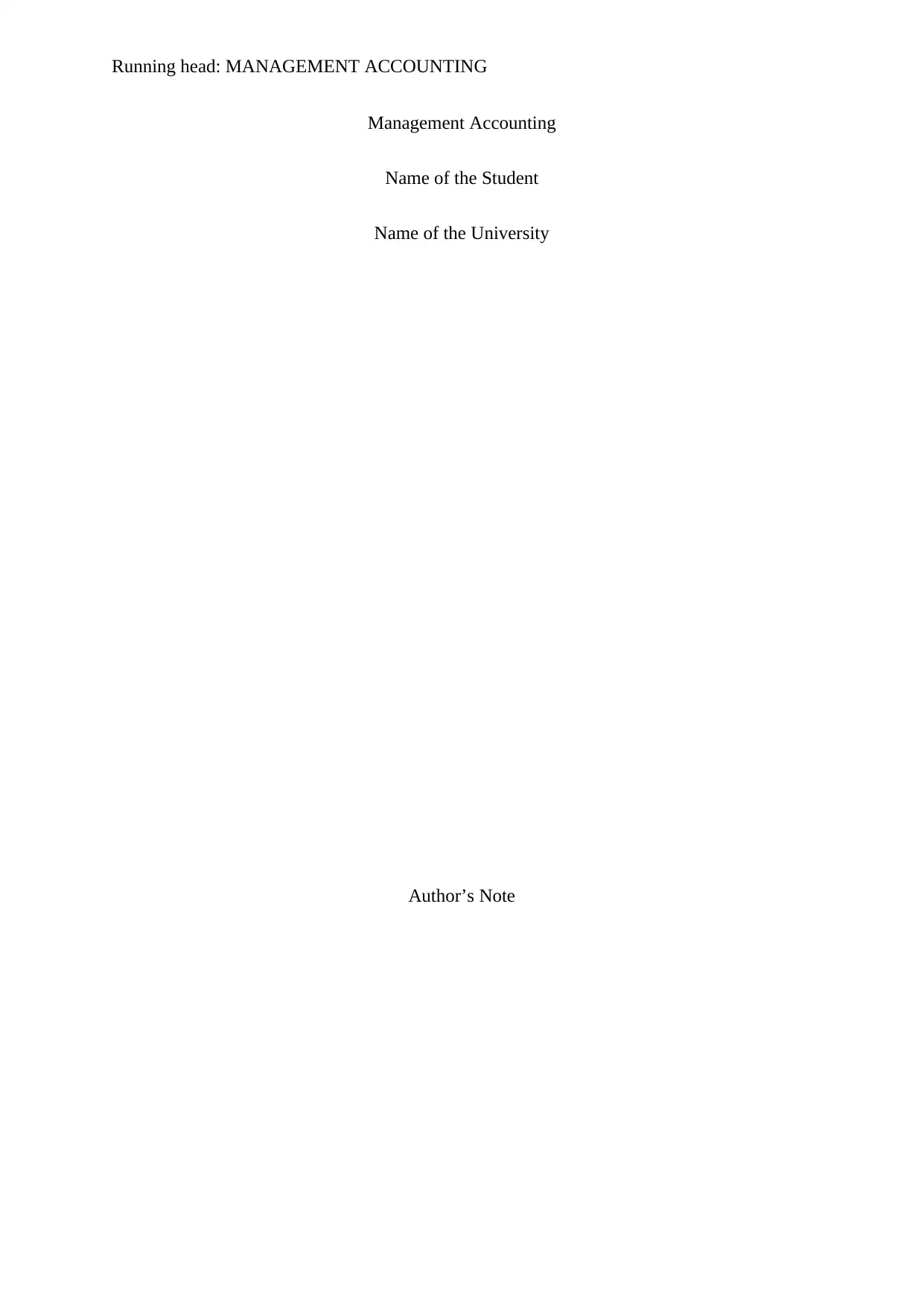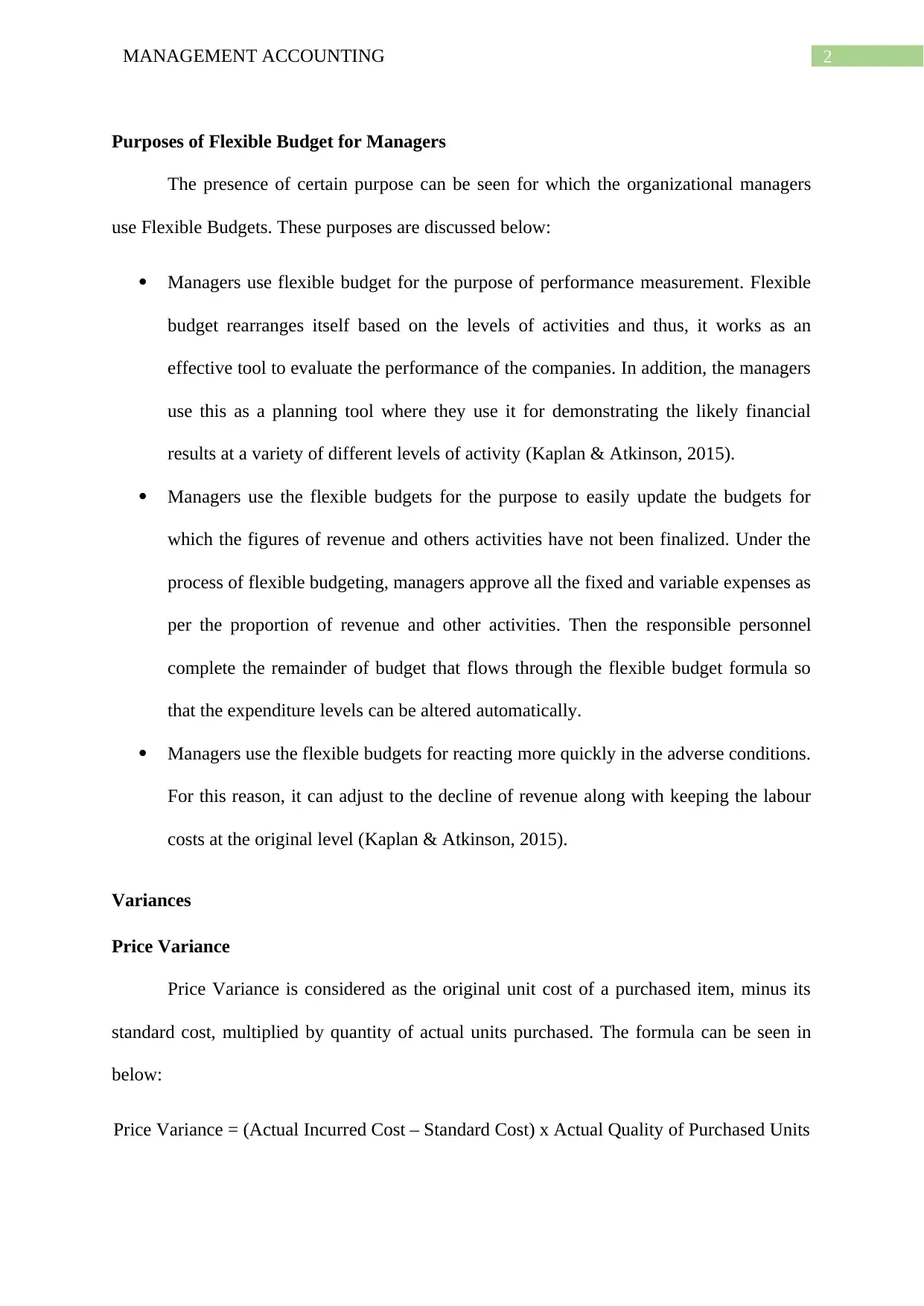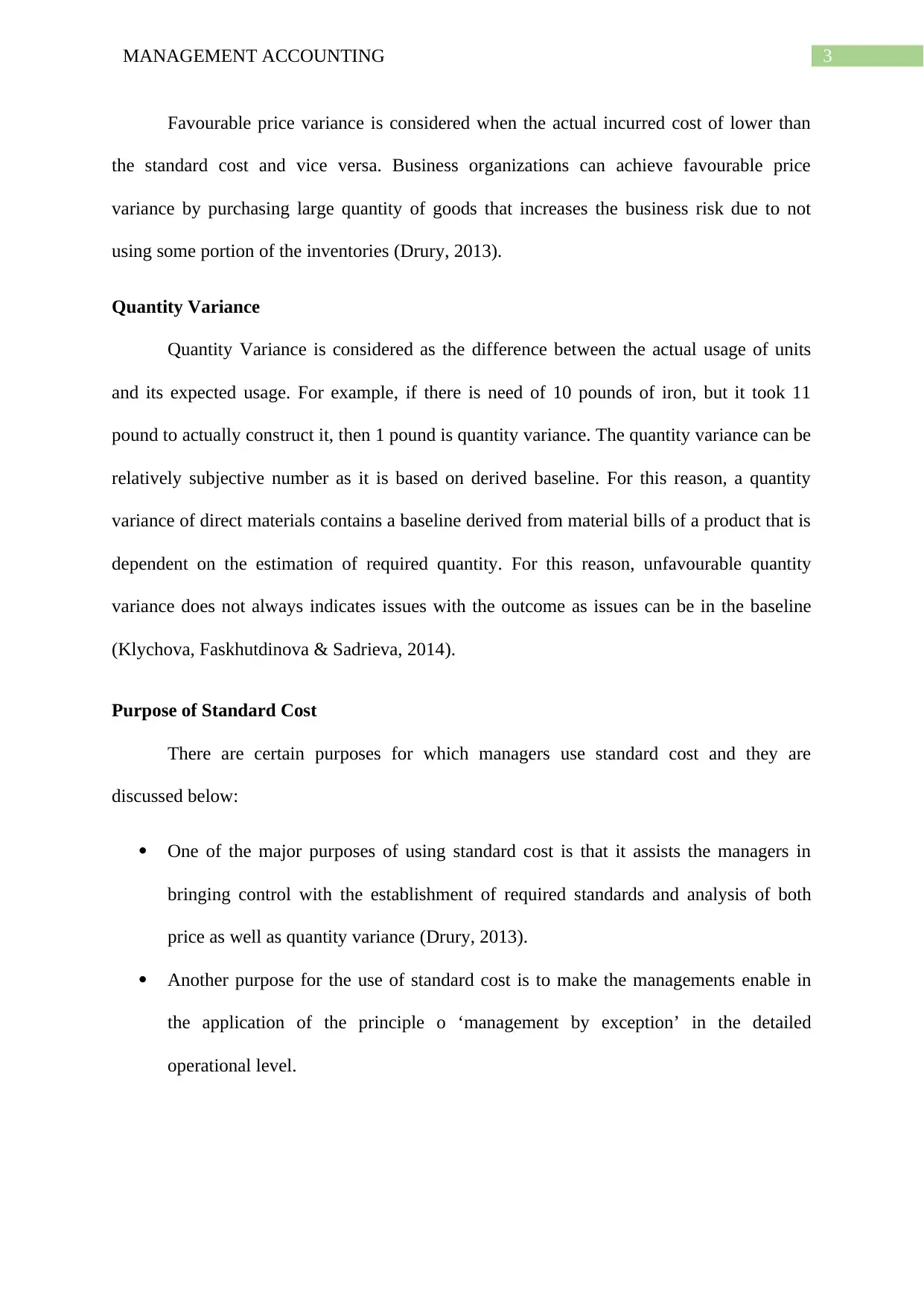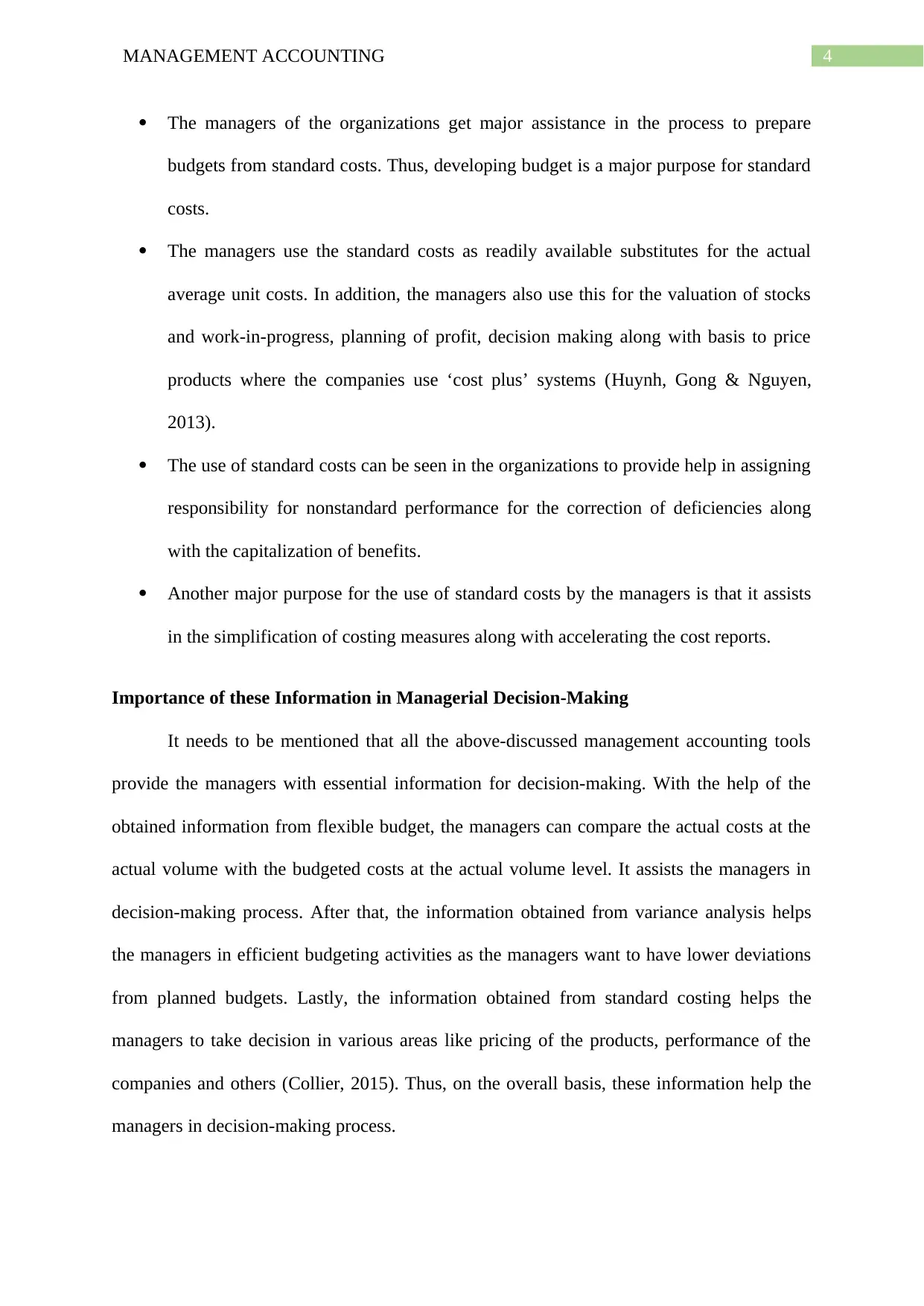Management Accounting: Flexible Budgets, Variances & Decision-Making
VerifiedAdded on 2023/04/20
|6
|1095
|492
Essay
AI Summary
This essay delves into the core aspects of management accounting, focusing on the purposes and applications of flexible budgets, variance analysis (price and quantity variances), and standard costing. It elucidates how managers utilize flexible budgets for performance measurement, budget updates, and quick responses to adverse financial conditions. The analysis of price and quantity variances provides insights into cost control and operational efficiency. Standard costing is examined for its role in establishing cost control, aiding in budget preparation, and facilitating decision-making processes, such as product pricing and performance evaluation. Ultimately, the essay highlights the importance of these management accounting tools in providing essential information that supports informed managerial decision-making across various organizational functions, enabling better financial planning, cost management, and strategic alignment.

Running head: MANAGEMENT ACCOUNTING
Management Accounting
Name of the Student
Name of the University
Author’s Note
Management Accounting
Name of the Student
Name of the University
Author’s Note
Paraphrase This Document
Need a fresh take? Get an instant paraphrase of this document with our AI Paraphraser

1MANAGEMENT ACCOUNTING
Table of Contents
Purposes of Flexible Budget for Managers................................................................................2
Variances....................................................................................................................................2
Price Variance........................................................................................................................2
Quantity Variance..................................................................................................................3
Purpose of Standard Cost...........................................................................................................3
Importance of these Information in Managerial Decision-Making............................................4
References..................................................................................................................................5
Table of Contents
Purposes of Flexible Budget for Managers................................................................................2
Variances....................................................................................................................................2
Price Variance........................................................................................................................2
Quantity Variance..................................................................................................................3
Purpose of Standard Cost...........................................................................................................3
Importance of these Information in Managerial Decision-Making............................................4
References..................................................................................................................................5

2MANAGEMENT ACCOUNTING
Purposes of Flexible Budget for Managers
The presence of certain purpose can be seen for which the organizational managers
use Flexible Budgets. These purposes are discussed below:
Managers use flexible budget for the purpose of performance measurement. Flexible
budget rearranges itself based on the levels of activities and thus, it works as an
effective tool to evaluate the performance of the companies. In addition, the managers
use this as a planning tool where they use it for demonstrating the likely financial
results at a variety of different levels of activity (Kaplan & Atkinson, 2015).
Managers use the flexible budgets for the purpose to easily update the budgets for
which the figures of revenue and others activities have not been finalized. Under the
process of flexible budgeting, managers approve all the fixed and variable expenses as
per the proportion of revenue and other activities. Then the responsible personnel
complete the remainder of budget that flows through the flexible budget formula so
that the expenditure levels can be altered automatically.
Managers use the flexible budgets for reacting more quickly in the adverse conditions.
For this reason, it can adjust to the decline of revenue along with keeping the labour
costs at the original level (Kaplan & Atkinson, 2015).
Variances
Price Variance
Price Variance is considered as the original unit cost of a purchased item, minus its
standard cost, multiplied by quantity of actual units purchased. The formula can be seen in
below:
Price Variance = (Actual Incurred Cost – Standard Cost) x Actual Quality of Purchased Units
Purposes of Flexible Budget for Managers
The presence of certain purpose can be seen for which the organizational managers
use Flexible Budgets. These purposes are discussed below:
Managers use flexible budget for the purpose of performance measurement. Flexible
budget rearranges itself based on the levels of activities and thus, it works as an
effective tool to evaluate the performance of the companies. In addition, the managers
use this as a planning tool where they use it for demonstrating the likely financial
results at a variety of different levels of activity (Kaplan & Atkinson, 2015).
Managers use the flexible budgets for the purpose to easily update the budgets for
which the figures of revenue and others activities have not been finalized. Under the
process of flexible budgeting, managers approve all the fixed and variable expenses as
per the proportion of revenue and other activities. Then the responsible personnel
complete the remainder of budget that flows through the flexible budget formula so
that the expenditure levels can be altered automatically.
Managers use the flexible budgets for reacting more quickly in the adverse conditions.
For this reason, it can adjust to the decline of revenue along with keeping the labour
costs at the original level (Kaplan & Atkinson, 2015).
Variances
Price Variance
Price Variance is considered as the original unit cost of a purchased item, minus its
standard cost, multiplied by quantity of actual units purchased. The formula can be seen in
below:
Price Variance = (Actual Incurred Cost – Standard Cost) x Actual Quality of Purchased Units
⊘ This is a preview!⊘
Do you want full access?
Subscribe today to unlock all pages.

Trusted by 1+ million students worldwide

3MANAGEMENT ACCOUNTING
Favourable price variance is considered when the actual incurred cost of lower than
the standard cost and vice versa. Business organizations can achieve favourable price
variance by purchasing large quantity of goods that increases the business risk due to not
using some portion of the inventories (Drury, 2013).
Quantity Variance
Quantity Variance is considered as the difference between the actual usage of units
and its expected usage. For example, if there is need of 10 pounds of iron, but it took 11
pound to actually construct it, then 1 pound is quantity variance. The quantity variance can be
relatively subjective number as it is based on derived baseline. For this reason, a quantity
variance of direct materials contains a baseline derived from material bills of a product that is
dependent on the estimation of required quantity. For this reason, unfavourable quantity
variance does not always indicates issues with the outcome as issues can be in the baseline
(Klychova, Faskhutdinova & Sadrieva, 2014).
Purpose of Standard Cost
There are certain purposes for which managers use standard cost and they are
discussed below:
One of the major purposes of using standard cost is that it assists the managers in
bringing control with the establishment of required standards and analysis of both
price as well as quantity variance (Drury, 2013).
Another purpose for the use of standard cost is to make the managements enable in
the application of the principle o ‘management by exception’ in the detailed
operational level.
Favourable price variance is considered when the actual incurred cost of lower than
the standard cost and vice versa. Business organizations can achieve favourable price
variance by purchasing large quantity of goods that increases the business risk due to not
using some portion of the inventories (Drury, 2013).
Quantity Variance
Quantity Variance is considered as the difference between the actual usage of units
and its expected usage. For example, if there is need of 10 pounds of iron, but it took 11
pound to actually construct it, then 1 pound is quantity variance. The quantity variance can be
relatively subjective number as it is based on derived baseline. For this reason, a quantity
variance of direct materials contains a baseline derived from material bills of a product that is
dependent on the estimation of required quantity. For this reason, unfavourable quantity
variance does not always indicates issues with the outcome as issues can be in the baseline
(Klychova, Faskhutdinova & Sadrieva, 2014).
Purpose of Standard Cost
There are certain purposes for which managers use standard cost and they are
discussed below:
One of the major purposes of using standard cost is that it assists the managers in
bringing control with the establishment of required standards and analysis of both
price as well as quantity variance (Drury, 2013).
Another purpose for the use of standard cost is to make the managements enable in
the application of the principle o ‘management by exception’ in the detailed
operational level.
Paraphrase This Document
Need a fresh take? Get an instant paraphrase of this document with our AI Paraphraser

4MANAGEMENT ACCOUNTING
The managers of the organizations get major assistance in the process to prepare
budgets from standard costs. Thus, developing budget is a major purpose for standard
costs.
The managers use the standard costs as readily available substitutes for the actual
average unit costs. In addition, the managers also use this for the valuation of stocks
and work-in-progress, planning of profit, decision making along with basis to price
products where the companies use ‘cost plus’ systems (Huynh, Gong & Nguyen,
2013).
The use of standard costs can be seen in the organizations to provide help in assigning
responsibility for nonstandard performance for the correction of deficiencies along
with the capitalization of benefits.
Another major purpose for the use of standard costs by the managers is that it assists
in the simplification of costing measures along with accelerating the cost reports.
Importance of these Information in Managerial Decision-Making
It needs to be mentioned that all the above-discussed management accounting tools
provide the managers with essential information for decision-making. With the help of the
obtained information from flexible budget, the managers can compare the actual costs at the
actual volume with the budgeted costs at the actual volume level. It assists the managers in
decision-making process. After that, the information obtained from variance analysis helps
the managers in efficient budgeting activities as the managers want to have lower deviations
from planned budgets. Lastly, the information obtained from standard costing helps the
managers to take decision in various areas like pricing of the products, performance of the
companies and others (Collier, 2015). Thus, on the overall basis, these information help the
managers in decision-making process.
The managers of the organizations get major assistance in the process to prepare
budgets from standard costs. Thus, developing budget is a major purpose for standard
costs.
The managers use the standard costs as readily available substitutes for the actual
average unit costs. In addition, the managers also use this for the valuation of stocks
and work-in-progress, planning of profit, decision making along with basis to price
products where the companies use ‘cost plus’ systems (Huynh, Gong & Nguyen,
2013).
The use of standard costs can be seen in the organizations to provide help in assigning
responsibility for nonstandard performance for the correction of deficiencies along
with the capitalization of benefits.
Another major purpose for the use of standard costs by the managers is that it assists
in the simplification of costing measures along with accelerating the cost reports.
Importance of these Information in Managerial Decision-Making
It needs to be mentioned that all the above-discussed management accounting tools
provide the managers with essential information for decision-making. With the help of the
obtained information from flexible budget, the managers can compare the actual costs at the
actual volume with the budgeted costs at the actual volume level. It assists the managers in
decision-making process. After that, the information obtained from variance analysis helps
the managers in efficient budgeting activities as the managers want to have lower deviations
from planned budgets. Lastly, the information obtained from standard costing helps the
managers to take decision in various areas like pricing of the products, performance of the
companies and others (Collier, 2015). Thus, on the overall basis, these information help the
managers in decision-making process.

5MANAGEMENT ACCOUNTING
References
Collier, P. M. (2015). Accounting for managers: Interpreting accounting information for
decision making. John Wiley & Sons.
Drury, C. (2013). Costing: an introduction. Springer.
DRURY, C.M., 2013. Management and cost accounting. Springer.
Huynh, T., Gong, G., & Nguyen, A. (2013). Integrating activity-based costing with economic
value added. Journal of investment and management, 2(3), 34-40.
Kaplan, R. S., & Atkinson, A. A. (2015). Advanced management accounting. PHI Learning.
Klychova, G. S., Faskhutdinova, М. S., & Sadrieva, E. R. (2014). Budget efficiency for cost
control purposes in management accounting system. Mediterranean journal of social
sciences, 5(24), 79.
References
Collier, P. M. (2015). Accounting for managers: Interpreting accounting information for
decision making. John Wiley & Sons.
Drury, C. (2013). Costing: an introduction. Springer.
DRURY, C.M., 2013. Management and cost accounting. Springer.
Huynh, T., Gong, G., & Nguyen, A. (2013). Integrating activity-based costing with economic
value added. Journal of investment and management, 2(3), 34-40.
Kaplan, R. S., & Atkinson, A. A. (2015). Advanced management accounting. PHI Learning.
Klychova, G. S., Faskhutdinova, М. S., & Sadrieva, E. R. (2014). Budget efficiency for cost
control purposes in management accounting system. Mediterranean journal of social
sciences, 5(24), 79.
⊘ This is a preview!⊘
Do you want full access?
Subscribe today to unlock all pages.

Trusted by 1+ million students worldwide
1 out of 6
Related Documents
Your All-in-One AI-Powered Toolkit for Academic Success.
+13062052269
info@desklib.com
Available 24*7 on WhatsApp / Email
![[object Object]](/_next/static/media/star-bottom.7253800d.svg)
Unlock your academic potential
Copyright © 2020–2025 A2Z Services. All Rights Reserved. Developed and managed by ZUCOL.





